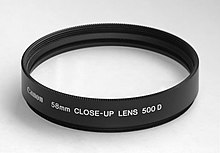Close-up lens



1 - Close-up lens.
2 - Camera objective lens (set to infinity).
3 Camera.
4 - Film or CCD plane.
y - Object
y" - Image
In photography, a close-up filter, close-up lens or macro filter is a simple secondary lens used to enable macro photography without requiring a specialised primary lens. They work identically to reading glasses, allowing any primary lens to focus more closely. It is actually more appropriate to use the close-up lens terminology as it is a lens and not a filter, although close-up lenses typically mount on the filter thread of the primary lens, and are manufactured and sold by suppliers of photographic filters. Some manufacturers refer to their close-up lenses as diopters, after the unit of measurement of their optical power.
While some single-element close-up lenses produce images with severe aberrations, there are also high-quality close-up lenses composed as achromatic doublets which are capable of producing excellent images, with fairly low loss of sharpness.
Close-up lenses are usually specified by their optical power, the reciprocal of the focal length in meters. Several close-up lenses may be used in combination; the optical power of the combination is the sum of the optical powers of the component lenses; a set of lenses of +1, +2, and +4 diopters can be combined to provide a range from +1 to +7 in steps of 1. A split diopter has just a semicircular half of a close-up lens in a normal filter holder. It can be used to photograph a close object and a much more distant background, with everything in sharp focus; with any non-split lens the depth of field would be far too shallow.
When you add a close-up lens to a camera which is focusing to infinity, and you don't change the focus adjustment, the focus will move to a distance which is equal to the focal length of the close-up lens. This is the maximal working distance at which you will be able to take a picture with the close-up lens. It suffices to divide 1 by D, the diopter value of the close-up lens, to get this maximal working distance in meters:
Sometimes that distance is also given on the filter in mm. A +3 filter will have a maximal working distance of 0.333 m or 333 mm.
The magnification reached in those conditions is the focal distance of the objective lens (f) divided by the focal distance of the close-up lens, i.e. the focal distance of the objective lens, in m, multiplied by the diopter value (D) of the close-up lens:
In the example above, if the lens has a 300 mm focal distance, magnification is equal to 0.3*3 = 0.9.
Given the small size of most sensors (about 25 mm for APS C sensors) a 20 mm insect will almost fill the frame at this magnification. Using a zoom lens makes it easy to frame the subject as desired.
When you add a close-up lens to a camera which is focusing at the shortest distance at which the objective lens can focus, and you don't change the focus adjustment, the focus will move to a distance which is given by following formula:
X being the shortest distance at which the objective lens can focus, in m, and D being the Diopter value of the close up filter. This is the minimal working distance at which you will be able to take a picture with the close-up lens.
For example, a lens that can focus at 1.5 m combined with a +3 diopter close up lens will give a closest working distance of 1.5/(3*1.5+1)=0.273 m.
The magnification reached in those conditions is given by following formula:
MX being the magnification at distance X without the close-up lens.
In the example above, the gain of magnification at Xmin will be (3*1.5 + 1)= 5.5.
It is at this Xmin distance that you will get the highest magnification.
To use a close up filter it is important to know those maximal and minimal distances, because only if you are within that range it will be possible to take a shot. There is not much of a range between the minimum and maximum values and the difference in magnification is quite moderate also.
The close up filters can turn telephoto lenses in macro lenses with a large working distance to prevent scaring small animals and a second advantage is the small size of the background making it easier to isolate the subject from messy surroundings. To use the filters for animals the size of the animal will determine the working distance (small snakes 1 m to 50 cm, lizards 50–25 cm, small butterflies, beetles 25–10 cm), so it is essential to know what will be the favorite subject before screwing on a close up filter. The close up filters are most effective with long focal length objectives and using a zoom lens is very practical to have some flexibility in the magnification. A good technique for sharp focussing is to take a picture at a long focal length first to have optimal sharpness at the essential details and then zooming out to have the desired size in the frame.
See also
External links
- Close focus Close-up lenses technique




